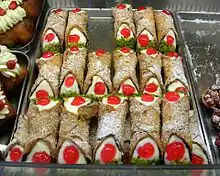Cannoli
Cannoli (Italian pronunciation: [kanˈnɔːli]; Sicilian: cannolu) are Italian pastries consisting of tube-shaped shells of fried pastry dough, filled with a sweet, creamy filling usually containing ricotta—a staple of Sicilian cuisine.[1][2] They range in size from 3.5 inches (8.9 cm) to 7.5 inches (19 cm). In mainland Italy, they are commonly known as cannoli siciliani (Sicilian cannoli).
.jpg.webp) Cannoli topped with chopped pistachios, candied fruit and chocolate chips sprinkled with confectioner's sugar | |
| Type | Pastry |
|---|---|
| Place of origin | Italy |
| Region or state | Sicily |
| Main ingredients | fried pastry dough, ricotta filling |
| Variations | Kannoli (Malta), Kanojët (Albania) |

Etymology
Cannolo is a diminutive of canna, 'cane' or 'tube'.[3]
In Italian, cannoli is grammatically plural; the corresponding singular is cannolo ([kanˈnɔːlo], Sicilian: cannolu), meaning "little tube". In English, cannoli is usually used as a singular, and cannolo is rare.[4]
History
Some food historians place the origins of cannoli in 827-1091 AD in Caltanissetta, the City of Women, by the concubines of princes looking to capture the prince's attention.[5]
Gaetano Basile merged this legend with other historical traditions to determine [6]Cannoli come from the Palermo and Messina[7] areas and were historically prepared as a treat during Carnevale season, possibly as a fertility symbol.[8] The dessert eventually became a year-round staple in Sicily.
Some similar desserts in Middle Eastern tradition include Zainab's fingers, which are filled with nuts,[9] and qanawāt, deep fried dough tubes filled with various sweets, which were a popular pastry across the ancient Islamic world. The dish and the name may originate from the Muslim Emirate of Sicily.[10] The Minne Di Sant'Agata or Minni di Virgini, cheese filled half spheres with icing and fruit are shaped like a breast in honour of St Agatha. Feddi ru Cancillieri is a similar cream and apricot jam filled almond cookie designed to look like the rear of a leader. [11]
See also
References
- Gangi, Robert (2006). "Cannoli". bestofsicily.com. Retrieved 15 May 2014.
- "The Cannoli of Piana degli Albanesi". A Taste of Travel. Retrieved 15 October 2014.
- Oxford English Dictionary, 3rd edition, 2003, s.v.
- Oxford English Dictionary, 3rd edition, 2003 s.v.
- "History of Sicilian Cannoli. A Sweet Mystery". JustSicily. 2017-11-14. Retrieved 2021-01-14.
- "The "spicy" history of cannoli Siciliani". Life in Italy. 2019-09-30. Retrieved 2021-01-14.
- "Scatti di gusto - 30 cannoli siciliani perfetti per un tentativo di classifica definitiva". Scatti di Gusto. Retrieved 15 October 2014.
- "The Cannoli and It's Rich History | Cannoli Kitchen". 2019-03-26. Retrieved 2021-01-14.
- Michael Krondl (2011). Sweet Invention: A History of Dessert. Chicago Review Press. p. 102. ISBN 9781556529542.
- Paul H. Freedman (2007). Food: The History of Taste (illustrated ed.). University of California Press. p. 159. ISBN 9780520254763.
- Petroni, Agostino. "The erotic origins of Italy's most famous sweet". www.bbc.com. Retrieved 2021-01-14.